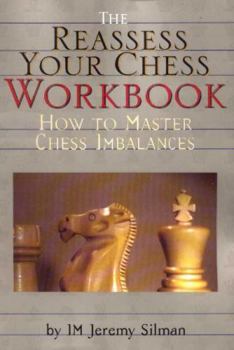Reassess Your Chess Workbook: How to Master Chess Imbalances
Select Format
Select Condition 
Book Overview
International Chess Master Jeremy Silman tests a player's strengths and weaknesses with 131 problems that cover openings, middlegames (both positional and tactical), and endgames. As a player... This description may be from another edition of this product.
Format:Hardcover
Language:English
ISBN:1890085057
ISBN13:9781890085056
Release Date:November 2000
Publisher:Siles Press
Length:423 Pages
Weight:1.55 lbs.
Dimensions:1.1" x 6.0" x 9.0"
Customer Reviews
4 ratings
terrific intro to positional thinking
Published by Thriftbooks.com User , 19 years ago
After almost twenty years languishing in the low 2000s (USCF), I finally began to understand positional play, the fight for the center and key squares, from this book. Silman's ideas are not new, but his simple explanations, practical examples, and constant repetition managed to get into my head what the two hundred other chess books on my shelf could not. After working through the examples in this book - yes, all of them, one by one, on a board, just a few each day - I find my understanding of chess at another level altogether. Now I feel ready to tackle my other favorite authors (Watson, Nunn, Dvoretsky), and to absorb the more subtle lessons they offer. If you buy TRYCW and let it sit on your shelf (as I did for two years), it won't help your chess at all. But if you put in the work, your efforts will be well repaid!
This book is a magnificent learning tool
Published by Thriftbooks.com User , 23 years ago
This book is in effect a "chess problem" book. The book offers 131 "problems" and their solutions. These problems are actually really more like tests by which means you can test yourself. The solutions part of the book offers actual instruction. Therefore, when you fail to solve the problem or fail to come up with the best move, you'll know where (and why) you went wrong (in the assesment of the position and/or why the plan and corresponding move chosen by you is not the best in the given position). This way you will quickly discover what you're doing wrong. The solutions part of the book is very well written and very clear. It does not contain endless variations, but a lot of words, thus written text. Therefore the solutions to the tests make a lot of sense and even seem obvious. This book is a logical follow up to Mr Silman's excellent "How to reasses your chess", but is perfectly readable separate of the aforementioned book. This book will ask you to think a lot, just like you have to do during an actual game. That is the difference between this book and other instructional chess books where everything is laid out for you. This book assumes some positional understanding on the part of the reader, but in fairness also offers a crash course in the front of the book. The bottom line is that this book is a magnificent learning tool and can't help but improve your game. This book is fun, but also a lot of work. I like it.
Workbook is Right!
Published by Thriftbooks.com User , 23 years ago
Why should you buy the Workbook if you've already read the earlier books? What's different about the Workbook is Silman's total emphasis on asking and answering lots of questions in detail that force the reader to actively participate. Silman presents a position and wants you to evaluate it, interrogate it, throw it against a wall and find out what's in its pockets before giving your plan and move. You will learn to create and use imbalances to devise plans and find moves in every stage of the game because the entire Workbook asks you to do nothing else. This isn't passive learning. It's more like, "Pop quiz, hot shot! Black has just played ...Nh5 and is going to win the two bishops. What do you do? What do you do?" You don't need to have read the earlier books since Silman gives a crash course on imbalances. If you've read them and felt you'd understood them (and yet didn't see any improvement as I had), this is another opportunity to get it right. Everyone has their own level of chess incompetence beyond which they will be unlikely to improve, and I may have already reached mine and you yours. But how can you be sure? "We can not know what is inevitable until we try good and hard to stop it."It's a fun read, too. (By the way, I actually worked through the entire book before I decided to "review" it. Maybe some of the other reviewers should've tried doing that.)
A very instructive book
Published by Thriftbooks.com User , 23 years ago
I really found this book very instructive. This unique workbook gives 131 problems with thorough solutions covering openings, tactics, strategy and endings. The idea behind this method is to teach the reader how to think at the chessboard. Players of all strengths can greatly improve by studying this book. Chapter 1 starts the book by examining a thinking methods to find candidate moves based on the recommendations of some great chess writers. This is an area where most players could use some advice. Chapter 2 looks at imbalances in chess. This is the key concept that the author will use to help the reader understand chess positions. The next parts of the book consists of the problems, followed by detailed solutions. This book can be read on it's own, although the companion "How to Reassess Your Chess" is also a classic. As a bonus, the book has nice photos of many great chess masters. This book is sure to become a classic.





